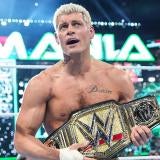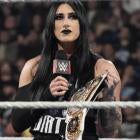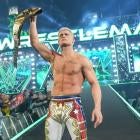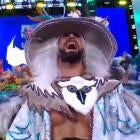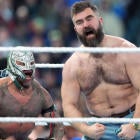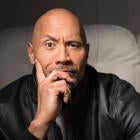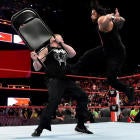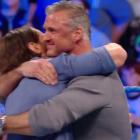
Sting is ready for his swan song. The legendary wrestler will make one final walk to the ring Sunday night in Greensboro, North Carolina -- the same arena where Ric Flair helped elevate him from a promising youngster to an emerging superstar. Sting links with Darby Allin for the 28th and last time as they defend the AEW tag team titles against the Young Bucks at AEW Revolution.
To survive nearly 40 years as a professional wrestler is incredibly uncommon. To do so as a star for multiple organizations is nearly impossible.
Sting on Sunday will rewrite the final chapter in a story that was nearly written for him. Steve Borden can move on with no regrets for how it ended. Meet "The Icon" and witness how he shaped so many people and promotions throughout his fabled career.
Thanksgiving visitors
Jerry Jarrett was a renowned wrestling promoter in Memphis beginning in the late 1970s. One day, Jerry received a photo of four bodybuilders from southern California.
"They had wrestling tights and boots but were very, very green as we call it," his son, famous wrestler and promoter Jeff Jarrett, told CBS Sports. "Out of those four they sent, my father, Jerry, pointed to Steve Borden and Jim Hellwig. He got the two guys on the phone."
Their lack of wrestling experience was of little issue. Wrestling could be taught but presence that jumped off the page could not. Jerry opened the door for them to work in the territory system of the mid-1980s.
"Sting and the Ultimate Warrior -- Steve Borden and Jim Hellwig -- drove cross country and arrived at my house on Thanksgiving Day. I'll never forget looking down from the second floor as they were walking up the sidewalk," Jeff Jarrett said. "I'm a junior in high school, a skinny little basketball player. They were two of the biggest guys I'd ever laid eyes on. I was like, 'Holy!'"
Following that meeting with Jerry, the come-to-be worldwide sensations lived the hard -- and financially perilous -- life of aspiring wrestlers on the low end of the match card, mostly out of Borden's car.
The duo eventually wrapped up their time with Jerry and the Continental Wrestling Association, moving on to Bill Watt's Universal Wrestling Federation as the Blade Runners. It was during this run that Borden adopted the moniker of Sting, eventually forging out on his own after Hellwig left the promotion.
Surfing the waves to glory
It didn't take long before Hellwig and Borden were quickly scooped up by major promotions. Hellwig, now in his Warrior persona, quickly rose through the ranks of the WWF (now WWE). Borden also found relatively fast success in the National Wrestling Alliance as a part of Jim Crockett Promotions.
"It didn't take that long for Sting to become a major star," legendary commentator Tony Schiavone, now one of the voices of AEW, told CBS Sports. "He wasn't one of those tremendous talkers like Ric Flair or Arn Anderson. He was different in that he shouted a lot; he screamed and he yelled. Fans bought into it. His excitement was contagious."
The initial version of Sting in the NWA was a bleach-blonde, neon-colored dynamo. The promotion was quick to show their belief in Borden's potential star power, placing him in the opening match of Starrcade, the NWA's first event ever broadcast on pay-per-view in 1987.
Borden's meteoric rise culminated in a legendary showdown with world heavyweight champion Flair. Three years after first lacing his boots, Sting headlined the inaugural Clash of Champions in 1988 against the living legend. Sting and Flair wrestled to a 45-minute, time-limit draw. It was the 23rd singles match between the two men, but none was as important as the meeting at Clash of the Champions, which aired live on TBS head-to-head with WWF's WrestleMania IV pay-per-view.
"It meant everything in the world to me," Borden told CBS Sports. "Anybody who had the opportunity to work with Ric Flair knew they'd hit the big time. They struck gold. For me, as a young kid a couple of years in the business, to be thrust into that position was validating. I felt validated."
The NWA needed a marketable act to move merchandise and lure advertisers -- a character that could cover posters, star in commercials and drive action figure sales. Sting had traction with the audience. He just needed a nudge over the edge.
"Flair was a master at making people stars," Schiavone said. "... Sting was one of those stars that he made on that day."
The trust that NWA put into Sting, a relatively unproven commodity, cannot be understated. The promotion was relying on Borden to headline an event directly opposite WrestleMania, a spectacle featuring massive stars such as "Macho Man" Randy Savage, Hulk Hogan, Andre the Giant and Borden's former traveling partner, the Ultimate Warrior. The decision to directly counter-program WrestleMania IV was largely retaliatory after WWF owner Vince McMahon threatened that anyone who aired Starrcade couldn't broadcast Survivor Series, WWF's other PPV, or WrestleMania.
"A lot of the cable systems turned and ran from Jim Crockett Promotions," Schiavone said. "I really think the attempt was at that time for Jim Crockett Promotions -- because of the clearance he had on TBS at that time -- would be the leader of the NWA promoters trying to battle back Vince going national. ... Clash of Champions -- a live event on TBS -- was probably the biggest blow we had against Vince McMahon at that time."
It wasn't just the fan response that spurred Crockett to put his chips behind Sting; the wrestler's attitude played a role. Despite his relative lack of experience, Borden was wise beyond his years.
"Backstage, Sting was just a good kid," Schiavone said. "He was not high maintenance. He was very willing to work. He got along extremely well with the other guys, the same way he does today. That goes a long way.
"Not everyone wants to lose. But the ones that can lose and realize it's not the end of the world will probably get ahead. Sting was like that."
The Crow hatches
For years, Sting was a cornerstone of the NWA, which eventually mostly consolidated and rebranded as World Championship Wrestling. Sting held several championships, including the world heavyweight title twice, as the wrestling landscape began to change rapidly.
"Cool" began to reign supreme over the long-standing juxtaposition between the simple concept of good vs. evil. Borden could see the writing on the wall as fans began to turn on even the biggest star wrestling had ever seen.
"I thought, 'They were booing Hulk Hogan now everywhere we go. It's just a matter of time now before they start booing me. They're going to get sick of the blonde hair and neon colors. I need to change,'" Borden recalled.
Hogan found his path to a new life when he teamed with Scott Hall and Kevin Nash as the New World Order in July 1996. The nWo became an immediate sensation, and Hogan's turn to the dark side -- complete with a dyed beard and Jimi Hendrix's "Voodoo Child" as entrance music -- freshened him up in the eyes of fans.
Later that year, Borden was walking down a hotel lobby in South Dakota when he found WCW creative boss Eric Bischoff having a conversation with Hall. (Hogan and Nash were also present, depending who tells the story.) Borden knew the existing version of the Sting character was on its last legs in a wrestling era more focused on "shades of gray," but it was Hall who laid the foundation for the necessary change, channeling the 1994 film "The Crow."
"Scott took hold of that character from the movie and said, 'You have that scary, spooky look coming down from the crowd,'" Bischoff told CBS Sports. "As Scott Hall was creating this character in real-time, I sat back and looked around. Everybody is hanging on every word he says."
Taking a proven commodity like Sting and dramatically transforming it is a big gamble. Bischoff did not hesitate.
"There was no consideration to the risk," he said. "The idea was so strong and the timing was so right that, while there was some risk, I didn't spend 30 seconds thinking about it, and I don't think Sting did, either."
According to Borden, there was hesitation on his part. After all, drastic changes to established characters had backfired many times in the wrestling business, as he'd seen up close and personal on more than one occasion.
"I knew it could potentially be another Shockmaster moment," said Borden, referencing the embarrassing debut and literal fall of Fred Ottman. Wearing a sparkly, silver "Star Wars" stormtrooper-inspired helmet, Ottman tripped with his helmet flying off his head after being introduced by Sting at Clash of the Champions XXIV in 1993.
"Honestly, I really did believe it could backfire in that way. … Of course, it was easy for Eric looking from the outside in to say, 'This is going to be great.' But I'm the one painting my face differently. I'm the one wearing the trench coat. I'm the one up in the rafters. I'm the one speaking no words. How will fans react to that? I knew it wasn't going to be one of those gray moments."
Sting's evolution into his "Crow" persona was laid brick-by-brick over multiple months. First, on the Oct. 21, 1996, episode of "WCW Monday Nitro," he appeared wearing white face paint in a style that reminded of his "Surfer" character. That night was the last time Sting spoke on camera for more than a year. He spent the next several months watching from the rafters while everyone from babyfaces (good guys) to the heels (bad guys) in the nWo tried to wrap their heads around his motives.
"It was a scary moment," Borden said of the night he debuted the new character direction. "I knew they were either going to hate it or love it -- no in-between. That's what's scary about it. Because if there's no in-between and it's not a win-win for everybody, you're not going to recover from something like that."
"There was only one person who could do it, and it was Steve Borden," Bischoff said. "He knocked it out of the freaking park."
While Borden's career had a new sense of momentum, his life was spiraling behind the scenes. The man behind the fresh black-and-white face paint was battling an addiction to painkillers, which he'd started taking due to trouble sleeping.
"I knew how dark it could get. I saw it all around me. I saw guys drop to the floor and start having seizures," Borden wrote in a 2022 article for The Player's Tribune. "I saw guys get paddles to the chest -- 'CLEAR!!!!' -- and get brought back to life. I went to friends' funerals. But, by 1998, it was inconceivable to me to stop taking painkillers. The mental and physical addiction was so intense and so deep that I knew that I was probably going to die, but there was nothing I could do about it. I was just … blank."
Borden had repeatedly lied to his wife about his substance abuse. It came to a tipping point in August 1998.
"I don't know why, but I simply could not lie anymore. I looked her in the eyes, and I told her everything," Borden wrote. "She fell in a heap on the floor, crying her eyes out. She couldn't even speak. She couldn't stand up. I had to carry her over to the bed. … Words can't do that moment justice. I had betrayed my wife and my kids. I was completely broken. I went into the closet and I got down on my hands and knees and I literally begged God to help me."
Borden had a spiritual revelation that day. He has been sober ever since. He doesn't make a habit of pushing his faith onto others, but ask how he's stayed grounded in an industry teeming with egos, and you'll see how profoundly he's guided by faith.
"My belief in God, my belief in Jesus Christ, his grace on my life -- I can't say enough about that," Borden told CBS Sports. "Anything good that has ever come out of me. Yeah, my dad taught me a lot, but we were a dysfunctional family and imperfect. You introduced Christ into our family, and my dad was a born-again believer as well in his later years; me, too, in my later years. That's where I think I can put all the credit is there for God. I give God all the glory and credit for all the good that ever came out of me."
Making another Impact
The final episode of "Nitro" aired on March 26, 2001, after the promotion had been purchased by McMahon and WWE. Appropriately, that final Nitro was headlined by Sting vs. Flair. WWE offered Sting opportunities to work for the company, but he declined.
"He was the guy, the poster boy for WCW in a lot of ways from the late '80s until the doors were shut," Jarrett said. "So, there was a lot of emotion that went into it for a lot of folks at WCW when the doors shut, but I think Sting's right at the top of that level."
Following the collapse of WCW, Borden enjoyed a brief run from 2003-04 in an upstart promotion called NWA Total Nonstop Action. Borden reunited with Jarrett, who ran the promotion with his father.
"Somewhere in his heartstrings, being sentimental tugged on him," Jarrett said. "He knew he got his start because of Jerry Jarrett and said, 'Hey, Jeff. I'm going to give this a shot.' Sting was just trying this out. I'm grateful that he did because, as TNA rolled along, having him be a part of the Rolodex -- not just in the ring but for licensing and international deals -- when you have Sting as part of your roster, it goes a long, long way."
Borden returned to TNA in late 2005, his first full-time commitment to a company since WCW folded. He introduced new variations to the Sting character from 2005-14, including a gimmick inspired by Heath Ledger's portrayal of the Joker in "The Dark Knight." He also had a rare bare-face run with the Main Event Mafia faction.
Borden aligned perfectly with TNA, which emerged as the leading the alternative to WWE. TNA gave Borden the creative freedom to preserve his character. In return, he lent his credibility to the company and helped establish future stars like AJ Styles, Christian Cage, Samoa Joe and Ron "The Truth" Killings (R-Truth).
"It's an intangible. You cannot quantify the value," Jarrett said. "In a lot of ways, if we had not gotten Sting, would we have gotten Kurt Angle? Would we have got other stars? Sting validated a young, upstart product simply by being one of the faces of it.
"When licensees, when television partners -- but probably most importantly the locker room -- sees a guy like Sting buy into the product and dig into the product, he cuts away all the excuses. If this guy is doing it -- he doesn't need the money or the fame, he's been at the very pinnacle of this industry, he could be home -- all those boxes Sting checked that he didn't have to, it completely validated us as a brand in so many ways. I'll be forever grateful not just to Steve Borden, but to the Sting character for how valuable he was to our product."
One story untold, another rushed
It took nearly 30 years after he began wrestling for Borden to make his debut in WWE, the industry leader. His arrival at the end of Survivor Series in 2014 brought fans closer than ever to one of wrestling's biggest dream matches: Sting vs. The Undertaker. Making that dream a reality drove Borden to WWE.
"I thought, 'Well, maybe if I get my foot in the door, we'll see what happens.' So, I got my foot in the door," Borden recalled. "We did a WrestleMania with Triple H, and then Vince called and said, 'Hey, I want you to have a world title match with Seth [Rollins]. Would you be willing to do that?' 'Yeah, I'd be willing to do that.' Still in hopes that somehow I could get in there with Taker.
"I think, if [the Undertaker match] was done right, it could have been a night for sure everyone would remember and never forget, and they would be talking about it to this day. But it just was not going to happen."
Sting lost a bizarre match to Triple H at WrestleMania 31 where he took a backseat to a convoluted time warp involving nWo and D-Generation X. He had a few subsequent matches involving the Big Show and John Cena before facing Rollins, the WWE world heavyweight champion, at Night of Champions in 2015. In that match, Sting suffered a legitimate neck injury taking a powerbomb into the turnbuckles.
"The power in my legs was just kind of going away," Borden explained during an appearance on Ric Flair's podcast in 2023. "I felt like I didn't have control over them, and I didn't. I had a temporary paralysis, and you know, for a few minutes, I thought, I don't think I can continue, I think I'm done."
Borden finished the match only to immediately be fitted into a neck brace and hospitalized.
"The doctor did tell my wife, 'He's going to have to get this dealt with. He's lucky he walked out of there,'" Borden said in an interview posted to WWE's website.
Doctors feared that Borden suffered cervical spinal stenosis, which generally caused by changes in the joints between those vertebrae. Borden later refused surgery, claiming it would end his career, because he was not experiencing symptoms typically associated with cervical spinal stenosis.
However, the injury encouraged him to retire. Borden announced his first retirement from professional wrestling during his WWE Hall of Fame induction speech in 2016.
The retirement snuffed out the final hopes of ever seeing Sting vs. Undertaker.
"Man, I would have loved to have seen that. If I could have had that, just that match alone, I would have been great," Borden said. "I wouldn't have had to do anything else."
Rewriting history
All Elite Wrestling launched in 2019, becoming the most significant North American alternative to WWE since WCW. Nearly two years after the brand's formation, Sting appeared on its flagship TV show, "AEW Dynamite." Perhaps it was fate that "Dynamite" aired on TNT, the same network that broadcast "Nitro" and his final match in WCW.
Sting's run with AEW has been nothing short of remarkable. His consistency as a performer and willingness to take risks -- often in the form of leaps from great heights onto his opponents -- has been extraordinary for someone pushing 65.
As Borden prepares for one final match in front of 16,000-plus fans, he's reminded this was never the plan.
"I didn't want to have real wrestling matches," Borden said. "I just didn't have confidence in myself that I'd be able to pull it off."
Borden had originally signed a three-year deal in which he would exclusively to perform in cinematic matches. These pretaped matches, which more closely resemble a low-budget action film, were utilized by WWE, AEW and other promotions during the crowdless days of the COVID-19 pandemic.
The ability to cut between scenes allowed Borden a more comfortable and controlled environment to approach his craft. He didn't think fans would take to the format. Not all cinematic matches are created equal, but some -- like The Undertaker's "Boneyard" retirement match against Styles at WWE WrestleMania 36 -- are remembered fondly.
While cinematic matches seemed viable for Sting, those around him had more in mind. Borden thought he might be able to compete in one final in-ring match. Darby Allin, who has partnered with Sting for all 27 of his AEW matches, company president Tony Khan and former executive vice president Cody Rhodes told him he had a lot left in the tank.
"Double or Nothing [PPV], we wrestled Ethan Page and Scorpio Sky," Allin recalled to CBS Sports about Sting's first match in front of a live crowd in six years. "We got to the back, and he looked at me and said, 'Darby, can I have a word with you? Thank you so much for convincing me to do this because what I felt out there, I've missed. The fact that I got to do it on my own terms,' considering he had that neck injury in 2015 where doctors said he'd never wrestle again."
Borden has wrestled more than two dozen matches since. His last comes alongside Allin against the Bucks on Sunday, March 3 at AEW Revolution.
More than 16,000 tickets have been sold for the event, nearly tripling the 6,000 in attendance for that Clash of Champions match. It's business as usual, practically speaking, but Borden admitted he would be lying if he said his emotions weren't heightened.
"The stress levels are a lot higher because I know there are going to be a lot of people watching," Borden said. "We're sold out in Greensboro. It'll be all over YouTube. Clips of it here and there. I have a lot of friends that will be there. Family will be there. So many different generations are going to be there. I just want it to be a night that everyone remembers.
"Whatever is left in my tank, I'm bringing it. I'll have some definite red blood cells moving through my body that night. I'll be psyched out of my mind, I'm sure."











